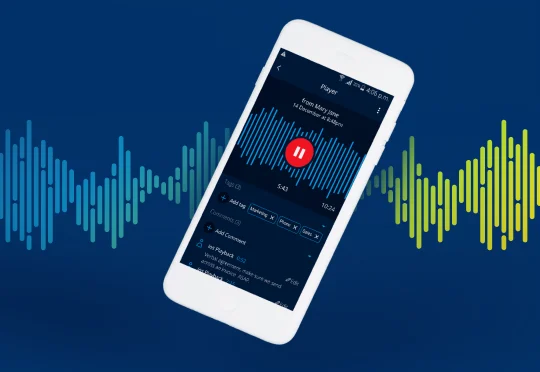
A business needs to listen to and understand two key groups. Sure, customers are vital, they are, after all, where the revenue comes from. But the front-line employees who determine how customers view your business are also important.
You can build loyalty with both groups and get to know them better by listening to what they say. The big question is how do you listen?
Start by putting humans first
Bots and automation have a place, yet for most of your customers, talking to a real person on the phone remains as important as ever. Want proof? More than seven in ten Americans would rather talk to a human than deal a chatbot or other automated process.
Chatbots and FAQs are best when it comes to dealing with minor queries. When a customer faces a bigger problem, they prefer to speak to a human. That means a phone call.
It’s not hard to see why. We know the three pillars of customer service are; a quick resolution, knowledgeable service agents, and a fast response. Customers feel valued when they speak to a knowledgeable agent who can respond in detail and at length. They want someone to listen to them.
The price of not listening can be high: Three out of four stop using an organisation’s services after a poor customer service experience.
So investing in customer service with a human voice makes good business sense.
Know your customer
Listening to customers makes them feel valued. It also gives you an opportunity to learn more about their needs and wants than you could ever get from an automated system.
By getting to know customers better, you can give them what they want. You can tailor your services, make appropriate offers. This pays off with more customer loyalty and that fuels more revenue.
Most businesses still have a long way to go when it comes to understanding customers. Almost a third of customers say they are frustrated that businesses don’t understand them or their needs.
One of the best ways to improve is by learning from mistakes.
Advances in voice AI and sentiment analysis provide the tools needed to filter negative calls to quickly identify customer complaints, or instances where customer service was lacking.
Understanding what your customers don’t like can be just as important as figuring out what they do. Analysing negative calls can identify areas for improvement – whether across products, services or experiences – and create opportunities for wins. Using data-driven decision making, businesses can increase sales, grow loyalty, and even improve their employee experience by reducing the number of negative customer calls they receive.
Do it right, do it once
One top customer frustration is having to repeat themselves when switching between channels or agents.
When a customer has to run through their problem a second time or repeat their personal details they see their call is not being resolved quickly. It also makes it look as if the person taking their call is not knowledgeable. That fails two of the pillars of customer service.
If you can’t provide a smoother, unified experience, your business will fall behind those who do. This is important if you offer omni-channel service. If you can’t offer it across a single service channel, you’re in trouble.
Pull it all together
Creating a unified customer experience needs a central repository of data from all previous conversations. The smartest way to achieve this is by using cloud native unified call recording that integrates voice data with existing business applications. Voice AI can turn those recorded conversations into a transcript.
When you pull data from previous conversations into a CRM system, data that includes a full transcript, your customer service agents can refer back to earlier conversations. This means customers don’t need to repeat themselves.
In the future consumers want more, not less, human interaction. Your business wants better customer interactions. Technology means you can do both at the same time. Better interactions mean you can make better personalised offers. You can adapt future conversations to the customer’s individual style and remember previous conversations so customers are not asked to repeat themselves.
Engage your staff
Your customer service employees define your customers’ relationship with your business. The more engaged they are, the better your business will perform. They’ll collaborate better and have higher productivity. Engaged workers are more likely to stay and less likely to take time off work. They will be enthusiastic about their work and about your business.
Keeping customer service workers engaged means a better customer experience. It also means cost savings: for a 100-employee organization, a 10 percent improvement in employee retention reduces costs by $50,000. If you can cut your staff turnover from 20 percent to 18 percent, that means two fewer employees to hire and onboard.
Staying engaged with remote working
Your customer service employees are more likely to stay engaged if you make their working life as easy as possible. That means giving them all the tools they need to do their job. This is especially true with remote workers who may miss human interaction.
Be wary of app fatigue. Using too many tools can disrupt workflows and drain productivity. Unified communications helps people stay focused. Most workers prefer the idea of having all communications in one place. Many workers believe a unified platform would help them achieve a better workflow, be more productive at work, and help work feel less chaotic.
Giving your workers a single, central repository of customer interactions will give them the insight they need to provide a better service.
Unified Call Recording and Voice AI
Unified call recording and voice AI will help you listen better to the voices that matter for your business. You’ll have a better understanding of your customers and their needs. At the same time, you’ll have valuable insights into keeping your employees engaged and focused.
Voice AI can bring things to your attention and even expose wants or needs that are not directly expressed. It can give you the information you need to deliver a better customer experience. You can reduce negative calls by learning from complaints. AI software can analyse and identify customer sentiment alerting you to problem areas. Positive calls can help you train staff and identify the best performers.
You can integrate AI voice and call recording into unified communications platforms and CRM to capture information at every customer touch point. This has the added benefit of easing app fatigue with your employees.
You can become a better listener by delegating some of the listening to Voice AI
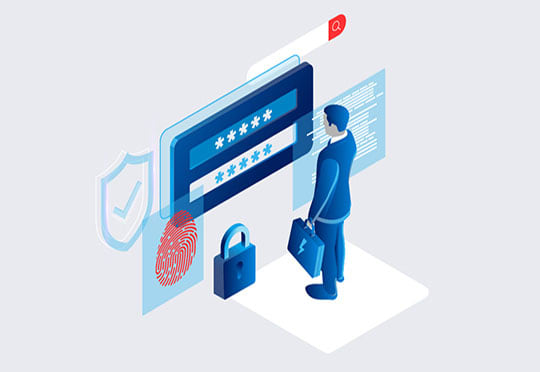
To protect and enable their employees, enterprises need to enable productivity without compromising on security. With centralised security controls, enterprises can grant access to business tools and applications without the headache of different login credentials for each system. In order to reduce IT complexity while retaining full control over employee access, enterprises are working with identity providers for their workforce.
Password fatigue is all too common, with the explosion of workflow applications and software tools that we use each day. It’s no surprise that password fatigue often results in credentials being recycled across multiple platforms and services. In fact, 80% of data breaches are caused by stolen, weak or default passwords. Identity providers not only relieve the burden of password fatigue but also mitigate risk of data breaches.
This is why our latest platform release includes the enablement of identity provider single sign-on (IdP SSO). This new functionality enables businesses to manage access to recordings on the Dubber platform through their existing identity provider (IdP).
IdPs create and maintain identity information for users within an enterprise, enabling them to authenticate access to business applications. When a business deploys an IdP, access to applications can be centrally managed through the IdP rather than requiring a separate authentication process for each application.
Take control of access to recordings
This new feature gives overarching control to enterprises. Just as they do with other applications within their business, systems administrators now have the option to grant their users access to the Dubber platform and customise this access at any time, using their chosen IdP – setting their own authentication requirements, access permissions or restrictions.
Users with correct permissions can use single sign-on (SSO) to access the Dubber platform with their IdP credentials. With access granted through the IdP, any advanced access controls such as multi-factor authentication, password strength, IP block-list or time restrictions will apply to Dubber.
Enable IdP SSO today
New Dubber customers can configure IdP SSO during account creation while existing customers can add this functionality by requesting it through their service provider, account manager, or support contact. Once IdP SSO is enabled, this will be the only authentication process that will allow access to the Dubber platform.
Contact your Dubber account representative or our support team for more information on how you can enable IdP SSO.
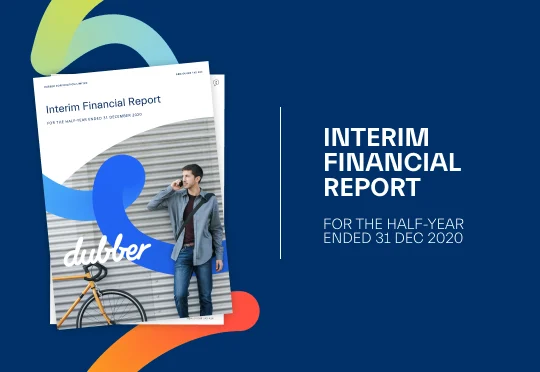
Download the Interim Financial Report for the half-year ended 31 Dec 2020 below.
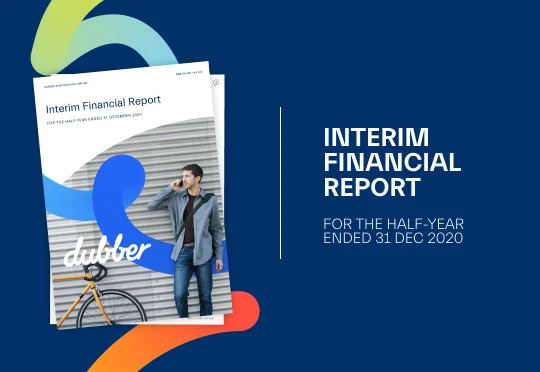
Download the Interim Financial Report for the half-year ended 31 Dec 2020 below
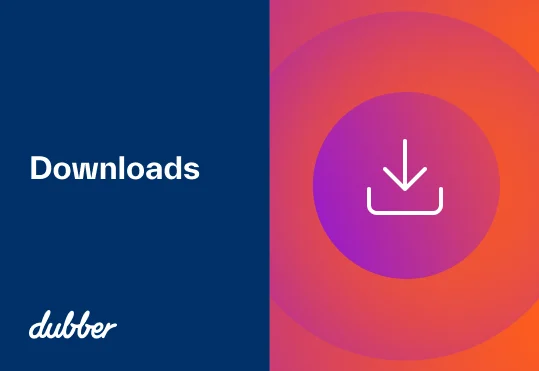
Half Yearly Report and Accounts

Dubber launches compliant Unified Call Recording and Voice AI on 3 AT&T Networks: AT&T IP Toll-Free Network, AT&T Hosted Voice Service and Cisco Webex Calling with AT&T Business in the United States
Melbourne, Australia, and Dallas, Texas – 23 Feb 2021 — Dubber Corporation Limited (ASX: DUB) (Dubber), today announced that AT&T Inc. (NYSE:T) has deployed its leading Unified Call Recording and Voice Intelligence solutions on the AT&T Network through AT&T IP Toll-Free, AT&T Hosted Voice Service (HVS), and Cisco Webex Calling with AT&T.
The collaboration of AT&T Business and Dubber brings the power of Dubber Unified Call Recording and Voice AI to customers already on AT&T IP Toll-Free. AT&T serves more than 3 million businesses globally including many of the Fortune 500 and enterprises across financial services, retail, healthcare, insurance and manufacturing sectors. AT&T IP Toll-Free is a SIP trunking service that delivers inbound toll-free calls to business customer locations over the entire AT&T network.
As a simple and easy to deploy feature upgrade, Dubber Unified Call Recording and Voice AI can be added to existing IP Toll-Free services. Customers can easily connect voice data – including conversational content, sentiment analytics and call meta-data to big data sets, applications such as Salesforce, and more.
“AT&T Business is again bringing industry-leading innovation to customers,” said Steve McGovern, CEO, Dubber. “By eliminating the costs of legacy on-premise and application-specific call recording and then automating compliance, customer experience and call centre activity enterprises can gain an immediate reduction in capital expenditure and drive increased productivity.”
“Voice data is one of the last great untapped resources for companies,” said Rich Shaw, Vice President, Voice & Collaboration, AT&T Business. “By making data and insights from conversations more accessible, we unlock the potential to drive digital and customer experience transformation through voice. With the pandemic and acceleration of remote work, moving to network-centric and unified call recording has never been more important. Together with Dubber, we can help answer these customer needs on a global scale.”
In addition to offering Dubber Unified Call Recording and Voice Data services with AT&T IP Toll-Free, the companies also announced Dubber Unified Call Recording service availability for businesses using Cisco Webex Calling with AT&T, as well as AT&T Hosted Voice Service (HVS) available today for United States customers.
This ASX release has been approved for release to the ASX by Steve McGovern, CEO & Managing Director.
About AT&T Communications:
We help family, friends and neighbors connect in meaningful ways every day. From the first phone call 140+ years ago to mobile video streaming, we @ATT innovate to improve lives. AT&T Communications is part of AT&T Inc. (NYSE:T). For more information, please visit us at att.com.
About Dubber:
Dubber is unlocking the potential of voice data from any call or conversation. Dubber is the world’s most scalable Unified Call Recording service and Voice Intelligence Cloud adopted as core network infrastructure by multiple global leading telecommunications carriers in North America, Europe and Asia Pacific. Dubber allows service providers to offer call recording for compliance, business intelligence, sentiment analysis, AI and more on any phone. Dubber is a disruptive innovator in the multi-billion dollar call recording industry, its Software as a Service offering removes the need for on-premise hardware, applications or costly and limited storage.
For more information, please contact:
Investors: Simon Hinsleysimon.hinsley@dubber.net+61 (0) 401 809 653
AU & NZ Media: Terry Albersteinterry@navigatecommunication.com.au+61 (0) 458 484 921
UK Media: James Taylor | The PR Network+44 (0)7796 138291james.taylor@thepr.network
US Media: Charlie Guyer, Guyer Group for Dubber+1.617.599.8830charlie@guyergroup.com

Today we announced another major deployment of Dubber – this time at the heart of one of the world’s largest networks – AT&T.
Dubber will be launching compliant Unified Call Recording and Voice AI on 3 AT&T Networks: AT&T IP Toll-Free Network, AT&T Hosted Voice Service and Cisco Webex Calling with AT&T Business in the United States. What makes AT&T so special is that they are the first of the major service providers to deliver on the promise of Dubber Unified Call Recording.
It’s an unequivocal validation of our strategy to enable conversations to be captured across multiple end-points and unified in the Dubber Voice Intelligence cloud.
This reflects how modern businesses operate. We jump from calls on Microsoft Teams and Cisco Webex to responding to customers on mobile devices and taking calls in service centres. What is crucial – for compliance, productivity, and visibility – is that all those calls can be integrated into one place and used to enrich systems of record like Salesforce.
That’s how, with AT&T, we can end not knowing for any business of any size. And that’s equally true for state and local government and education.
A Unified Approach.
Dubber is the only Unified Call recording and Voice AI solution running across multiple AT&T Voice business services – creating one place for all voice, video and text data to be harvested and leveraged instantly.
- AT&T IP Toll-Free
- AT&T Hosted Voice Services
- Cisco Webex Calling with AT&T
Native + Cloud = Advantage
Business, state and local government have been trapped for years on legacy call recording solutions often requiring hardware, storage (that increases in costs the more you record) and only connected to specific applications.
Together with AT&T, we will enable customers to capture conversations from any eligible end-point – a simple feature add-on, and then AI-enrich and store their voice data in one place. They’ll be able to access all this safely and securely, meeting critical compliance and regulatory mandates.
Data is immediately available to analyze and to pull key insights from. Key insights that make material improvements to business operations, customer experience, and compliance mandates, all of which takes place in a vastly more dispersed work environment than ever before.
As a simple and easy to deploy feature upgrade, Dubber Unified Call Recording and Voice AI can be added to any of the listed AT&T services. Customers can easily connect voice data – including conversational content, sentiment analytics and call meta-data to big data sets, applications such as Salesforce, and more.
Central to the Dubber on AT&T offering is compliance. Not just that experienced by Financial Services enterprise and others in regulated industries, but also regulations such as PCI and HIPPA. Answering the broad range of compliance mandates faced by a business means Dubber on AT&T addresses every element of compliance – from how calls are recorded to what data is retained to how data is stored.

The unprecedented events of 2020 drove adoption of Microsoft Teams globally as businesses were forced to adapt rapidly to continue their operations with a dispersed workforce. Ensuring continuing compliance with industry regulations has been a challenge for enterprises using Microsoft Teams, until now.
The Importance of a Certified Compliance Call Recording for Microsoft Teams
An automated, policy-based recording solution certified by Microsoft that seamlessly integrates with Microsoft Teams is a critical piece of communication infrastructure. It is also essential for ensuring Microsoft Teams communications compliance.
Dubber is among the first Call Recording solutions to achieve compliance call recording certification for Microsoft Teams. And from what we can tell, the only certified call recording solution capable of delivering Unified Call Recording.
What makes Compliance Unified Call Recording different?
Legacy call recording solutions capture call recordings from a small range of end-points; they are often specific to an application; and typically require hardware, software and professional services. Dubber is truly network native and cloud based. This means compliance call recording is provisioned with a click, any number of endpoints can be captured, and any recordings can be stored in the infinitely scalable Voice Intelligence Cloud.
Just like Dubber is native to Microsoft Teams, it will work as well for mobile, desk-phones and more. And it’s open API and out-of-the-box integrations with popular software like Salesforce mean you’re not tied to seeing your voice data, beautiful transcriptions and AI-enriched insights in Dubber.
Enabling Continuous Compliance for Microsoft Teams Customers
Businesses in regulated industries such as banking, government, insurance and financial services sectors can now meet their legal and regulatory obligations for Microsoft Teams users in call centre, branch, and work-from-home environments simply, easily, and with confidence.
By recording calls with Dubber, financial services firms can use Microsoft Teams with confidence knowing that they can automatically record, store and encrypt all call data as required by HIPAA, GDPR, PCI DSS, KYC, Dodd-Frank, MiFID II, and more.
Dubber’s cloud based compliance call recording solution frees financial institutions from the restrictions of application-specific and infrastructure-based call recording normally confined to call center environments. Dubber offers a cloud-native solution that records directly from the network to complement remote working.
Discover the gold standard in compliance call recording for Microsoft Teams today.

Download the Q2 FY21 Investor Update below.
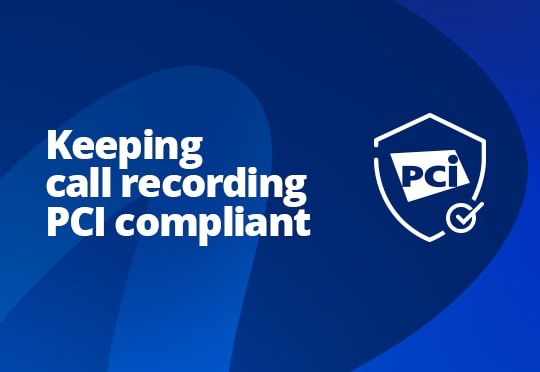
Not all information is equal. Some can be stored and used. Other information can’t.
The question is how to separate what can and can’t be recorded and stored when your aim is to capture crucial conversations while also ensuring PCI DSS compliance.
Fortunately there are solutions, but not all are created equal.
The dangers of redaction
There is an old saying: prevention is better than cure. As far as PCI solutions for call recording go, there are preventative measures and there are cures. PCI redaction solutions are cures. Customers give all of their payment information to contact centre agents while the call is being recorded. Not only is the information taken by the agent, but it’s now been processed and recorded. Redaction solutions rely on AI to detect the correct information to delete and no solution is 100% effective.
PCI compliant call recording options
Now for the preventative measures: pause and resume and payment gateways. These solutions stop identifiable information from ever being recorded, so there’s no need for an AI bot to go through recordings and transcripts with a black pen.
PCI compliant payment gateways
Payment gateways are the ultimate gold standard in PCI compliance solutions. Not even the contact centre agent has any knowledge of the customer’s details as these are entered by the customer through their keypad. Any dual-tone multi-frequency (DTMF) tones are masked and the agent sees asterisks appear on their screen instead of characters.
Pause and resume for PCI compliance
Payment gateways aren’t for everybody. Depending on the PCI requirements of your business and your budget, a pause and resume solution may be more suitable. Choose from manual or automatic options, depending on your needs.
Manual solutions put the pause and resume of recording in the hands of contact centre agents – allowing them to stop recordings when sensitive information is about to be shared. Of course, this method opens up the potential for human error.
PCI DSS guidelines recommend that merchants using this method check their recordings weekly for identifiable information.
Automatic pause and resume is triggered by window or URL changes, or through custom triggers using an API. Desktop clients don’t require any custom developments and can be easily integrated, while API solutions are more robust, with a lower risk of end-user interference.
Chat to a Dubber compliance expert today to understand how to address PCI compliance when recording calls and storing conversational data.

